Fujifilm X-E1 Review
Fujifilm X-E1 Introduction
The Fuji X-E1 is the second Fuji SLD and it aims directly at the high-end market with its unique 16 megapixels X-Trans CMOS sensor and very mechanical retro design. It uses an 1.5X crop sensor with a 3:2 aspect ratio, just like the majority of DSLRs, except that forgoes an anti-alias filter thanks to its unique color-filter-array which is not prone to Moire artifacts.
The X-E1 uses Fuji's own XF lens mount which has a very short flange distance. This makes it easier to design high-quality lenses and lens-mount adaptors, including one made by Fuji for the Leica M-mount. Fuji launched a total of five lenses so far, mostly bright prime lenses, rather than the usual zooms, reinforcing the X-E1 as a high-end offering with a small footprint. This is crucial for SLDs since they must provide a clear advantage over DSLRs which have an iron-grip on the high-end digital camera market.
This digital camera follows the X-Pro1 with the same amazing X-Trans sensor in a more compact body with a much improved all-electronic viewfinder, rather than the unique but mostly pointless hybrid one of its predecessor. There design and feature set remain the same yet Fuji managed to price the X-E1 a whole $700 USD.
Since the Fuji X-E1 is so similar to its predecessor, large parts of this review are taken from the Fuji X-Pro1 Review. Differences are highlighted below in green, just like this text.
This digital camera review analyses the usability, performance and image quality of the Fuji X-E1.
Fuji X-E1 Features
Sensor
- 16 Megapixels CMOS sensor
- X-Trans Color-filter array
- No Anti-Alias filter
- 1.5X Crop factor (APS-C)
- 3:2 Aspect ratio
- Fuji XF lens mount
- Built-in Dust-Reduction
Exposure
- ISO 200 to 6400 sensitivity range, 1/3 EV steps
- ISO 100, 12800 and 25600 expansion, JPEG only
- Auto ISO, Selectable maximum from 400 to 3200
- ISO Bracketing, 3 frames, 1/3, 2/3 or 1 EV steps
- 1/4000-30s Shutter-speeds, 1/3 EV steps
- Bulb exposure, maximum 1 hour
- PASM Exposure modes
- Multi-Segment, Spot and Average metering
- Exposure-Compensation, ±2, 1/3 EV increments
- Auto-Exposure Bracketing, 3 frames, 1/3, 2/3 or 1 EV increments
- Automatic and selectable Dynamic-Range, 100%, 200% or 400%
- Dynamic-Range Bracketing, 3 frames
- Flash-Compensation, ±2/3 or 1/3 EV increments
- Auto, Forced, Slow-Sync, Rear-Sync and Off Flash modes
Image Parameters
- Automatic, 8 presetsSunny, Shade, Cloudy, 3 Fluorescents, Incandescent, Underwater, Kelvin and Custom WB
- WB fine-tuning along 2 axis in 19 steps
- Film Simulation: Provia, Velvia, Astia, Pro Negative Hi, Pro Negative Standard, B&W plus 3 optional filters, Sepia
- Film Simulation Bracketing, 3 frames
- Noise reduction, 5 levels
- Optional Long-Shutter noise reduction
- Adjustable Color, Sharpness, Highlight Tone, Shadow Tone, 5 steps each
Focus
- Single-shot or Continuous autofocus
- Manual-focus (MF), Electronic Magnification
- Automatic or Manual focus-point selection
- 49-areaOnly 25 areas when susing OVF AF system
- Optional MF-Assist view
- Optional AF-Assist lamp
- Fly-By-Wire focus ring on lenses
Drive
- 6 FPS Continuous Drive
- 20 JPEG or 12 RAW Buffer
- Multiple-Exposure, 2 frames
- Self-timer, 2s or 10s
Video
- 1920x1080 @ 24 FPS Video
- 1280x720 @ 24 FPS Video
- MPEG-4 codec
- Stereo sound
- Mini-Jack audio input
Display & Viewfinder
- 0.5" EVF, 2.4 Megapixels, 100% Coverage
- 2.8" LCD, 460K Pixels
- Eye-Start sensor
- Digital Level, 1-axis
- Depth-Of-Field Preview
- Optional Live-Histogram
- Optional Framing-Guides, 3 types
Output Processing
- 3:2 Native aspect ratio
- 16:9 and 1:1 cropped aspect ratios
- 16, 8 and 4 megapixels modes
- JPEG, RAW, RAW+JPEG capture
- 2 JPEG Compression levels
Misc
- Customizable AE-L / AF-L button
- Customizable Function (Fn) button
- Full-stop shutter-speed dial
- Aperture ring on lenses
- Third-Stop EC dial
- One adjustment-dial
- Standard Hot-Shoe
- HDMI (1080i) output
- USB 2.0 connectivity
- SDXC memory
- Lithium-Ion battery
- Built-In popup flash
Fujifilm X-E1 Suitability - What is it good for?
The Fuji X-E1 features a 16 megapixels sensor with a unique color-filter array which does not require an anti-alias filter. Normally, an anti-alias filter is placed right in front of the sensor to very slightly blur light reaching the sensor. This avoids the sensor trying to resolve details which are too fine and could result in Moire artifacts. The side-effect of this is that most camera sensors never get as much details as they can capture, assuming a high quality lens, of course. Incidentally this has been a selling point for cameras using Foveon sensors as well as the Pentax K-5 IIs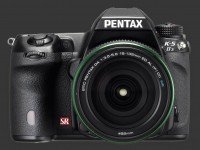
Pentax K-5 IIs DSLR which is the no-anti-alias-filter version of the K-5 II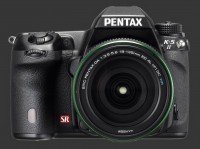
Pentax K-5 II.
Having such a high-resolution sensor without an anti-alias filter makes the X-E1 suitable for large prints with extremely sharp details, as long as the lens in use is sufficiently sharp. This is probably why Fuji started the XF-mount with high-quality prime lenses. Otherwise, they might have wiped out the resolution advantage of the new X-Trans technology. Incidently, the review unit of the X-E1 camera with the only XF-mount zoom which appears to have done just that for the convenience of zooming.
The sensor in this Fuji is as large as is currently found in Sony SLDs and in the Pentax K-01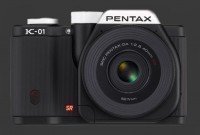
Pentax K-01 which gives it good resistance to image noise. With a standard ISO range reaching 6400, the Fuji X-E1 can work in rather low-light. Those shooting JPEG images also have access to expanded sensitivities up to 25600 and ISO 100.
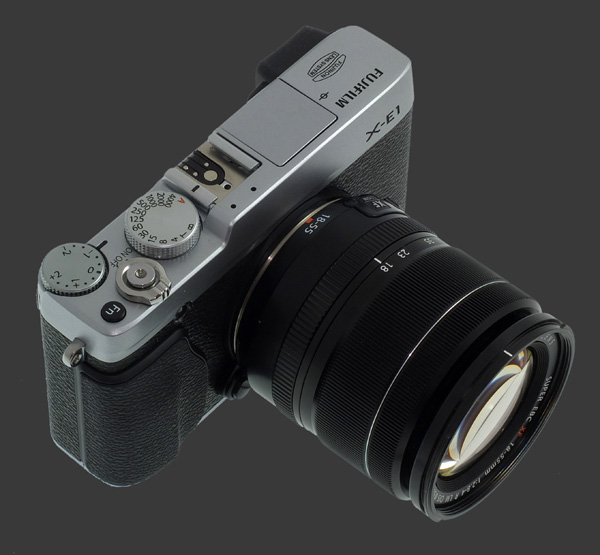
Shutter-speeds from 1/4000 to 30s are available at any ISO. It is also possible to perform bulb exposures for up to one hour. For this, it is highly recommended to use a remote-release and the X-E1 supports both a traditional mechanical and an electronic cable.
This digital camera is built in a tough metal body with plenty of external controls including direct dials for shutter-speed, exposure-compensation and aperture (on the lens) for efficient access. Despite the high-end build, the X-E1 is not weather-sealed and neither are any current XF-mount lens. This makes it suitable for professional use but not in adverse weather conditions.
The Fuji X-E1 features a class-leading EVF with Eye-Start sensor. The EVF measures 0.5" and is made of an OLED panel with 2.4 megapixels of resolution, the highest resolution available today. The image is extremely detailed, bright and shows good contrast. Motion is quite fluid too but slows down a little in low-light.
The EVF, just like the rear LCD, shows 100% coverage. Sadly, this view is not Exposure-Priority, negating the most fundamental advantage of EVFs over OVFs. The optional Live-Histogram is of no help either since it is based on the display brightness.
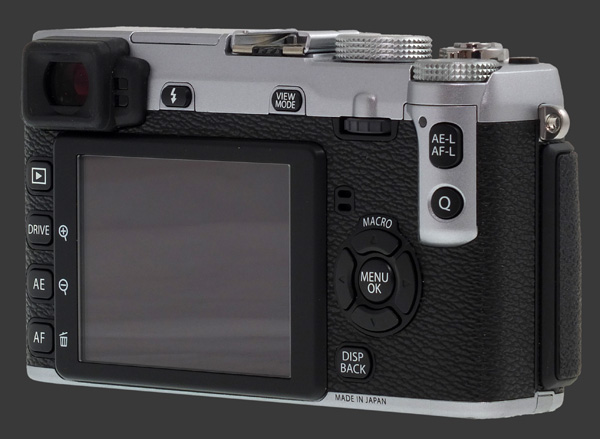
A full complement of manual controls, including manual focus, choice of metering modes and custom white-balance gives photographers complete control over the creative process with the X-E1. There is also a RAW mode for those who with to process their images differently than the camera. This shortens the buffer-depth for 6 FPS continuous shooting from 20 to 12 which is still sufficient to capture the height of action with up to 2s of anticipation.
The Fuji X-E1 is suitable with most types of photography within the limitations of available lenses, which we discuss in the next section of this review. The lack of weather-sealing seems a curious choice by Fuji but should also be considered when deciding if the X-E1 fits your needs.
Fujifilm X-E1 Fuji XF-Mount Lenses
Fuji currently makes only 5 lenses made for the XF-mount. The initial three primes, an 18mm, 35mm and 60mm are discussed in depth in the Fuji X-Pro1 Review. Considering the APS-C sensor-size of the X-E1, these are roughly equivalent to 28, 50 and 90mm lenses on a film or full-frame camera. Fuji later added the another prime and a zoom which are described here.
All Fujinon XF-mount lenses share a similar design with a metal body and very smooth finish. The build quality is excellent yet they feel surprisingly light for their size. They all have an aperture ring with very soft detents, so it is rather easy to accidentally change settings. This happens while mounting and unmounting the lens. Maybe future lenses will improve this but we are unlikely to see a fix for the current ones.
All current XF-mount lenses have a fly-by-wire focusing ring with a fine texture to prevent slipping. The same fine texture is unfortunately prone to holding on to particles and is difficult to clean. The focus ring itself turns super smoothly but it looks like the camera adjusts focus in small discreet steps. There is quite a bit of throw to focus from up-close to infinity, which helps with precise focusing. Focusing quickly for street photography is less than ideal though.
Fujinon XF 14mm F/2.8R
The Fujinon XF 14mm F/2R is an ultra-wide-angle lens with a good maximum aperture. With an equivalent focal-length of 21mm, the field-of-view is 89°. This is often used for shooting large structures and tight spaces. It gives a visibly exaggerated perspective which is a hallmark of ultra-wide lenses.
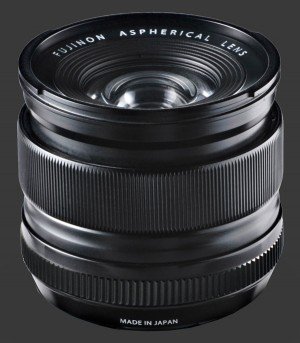
Like all XF-mount prime lenses, the aperture ring on this one has an A position to let the camera automatically choose the aperture. When both the ring and shutter-speed dials are set to A, the camera in in Program mode. When only the aperture ring is set to A, it is in Aperture-Priority mode.
Fujinon XF 18-55mm F/2.8-4R LM OIS Lens
The first zoom in the Fuji lineup, the Fujinon XF 18-55mm F/2.8-4R is half-a-stop brighter than kit lenses from other manufacturers. It is the first Fuji lens with image stabilization, controlled by a small sliding switch on the side of the lens barrel. It incorporates a linear motor to autofocus quickly and extremely quietly.
The fly-by-wire focus ring is just as smooth as on other Fuji XF lenses. It has a luxury feel with well-dampened movement to prevent accidental rotation. Behind it is a mechanical zoom ring which also turns smoothly with good resistance.
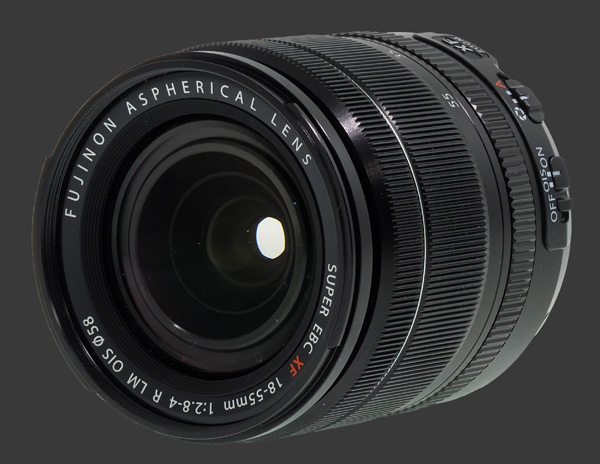
The aperture-ring of this lens is unmarked. Its click stops step the aperture in 1/3 stops relative to the maximum aperture of the lens at the set focal-length. This avoids the awkward state of being able to set an aperture ring to an F-stop which is unavailable. To allow for both Program and Shutter-Priority exposure with this design, the XF 18-55mm F/2.8-4R features a small sliding switch to choose between automatic and manual aperture control. In the A position, the aperture ring is simply ignored.
This lens is relatively compact and feels quite solid with a confidence-inspiring weight. It is clearly more dense than the prime lenses but does not feel heavy. Unlike the prime lenses, this one gets a plastic rather than metal bayonet-mount hood.
More XF Lenses
According to the Fuji lens road map, five more lenses are also scheduled to appear in 2013: a 23mm F/1.4 and 27mm F/2.8 pancake early in the year, plus a 56mm F/1.4, 10-24mm F/4 ultra-wide zoom and a 55-200mm F/3.5-4.8 zoom. Both zooms are expected to be stabilized.
Samyang is the first third-party to make XF-mount lenses, with their 8mm F/2.8 Fisheye already available. The high-end lens manufacturer, Carl Zeiss has also announced several XF-mount prime lenses.
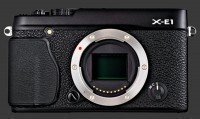 |
Please Support Neocamera
All information on Neocamera is provided free of charge yet running this website is a huge endeavor. Purchases made via affiliate links found throughout the site help keep it running and up-to-date. There is no additional cost to you, so please consider buying via these links to our affilates:
Thank you for your support!
Fujifilm X-E1 Highlights

Sensor-Size: 24 x 16mm

Actual size when viewed at 100 DPI
| 16 Megapixels Mirrorless | ISO 100-25600 |
| Fujifilm X Mount 1.5X FLM | Shutter 1/4000-30s |
| 0.50" Built-in EVF 2.4 Megapixels (0.62X) | Full manual controls, including Manual Focus |
| Automatic Eye-Start sensor | Custom white-balance with 2 axis fine-tuning |
| 1 Axis Digital Level | Spot-Metering |
| Built-in Dust Reduction | Hot-Shoe |
| 6 FPS Drive, 20 Images | Stereo audio input |
| 1920x1080 @ 24 FPS Video Recording | Lithium-Ion Battery |
| 2.8" LCD 460K Pixels | Secure Digital Extended Capacity |
Updates
2025.11.13

Best Gifts for Photographers in 2025 by Budget
The annual Neocamera Photography Gift Guide updated to 2025. Find great gifts for photographers with any price budget.
2025.07.07

Stellar Photo Recovery Review
Review of Stellar Photo Recovery V12. This Windows and MacOS software can recover photos and videos in a huge number of formats from memory cards, USB drives, SSDs and HHDs.
2025.05.14

Huion Kamvas 13 Gen 3 Review
In-Depth review of the Huion Kamvas 13 Gen 3 Pen Display Tablet for photographers and graphic artists.
2025.01.18

Fujifilm GFX 2025 Lens Roundup
Lens Review roundup of Fujifilm GFX Medium-Format lenses. Quality, performance and handling of the GF20-35mm F/4R WR, GF30mm F/3.5 Tilt-Shift and the GF55mm F/1.7.
2024.11.18

Best 2024 Photography Gifts for Every Budget
Great gifts for photographers and photo enthusiasts selected for every budget among the best products of 2024.
2024.08.07

Eye Protection Tips for Professional Photographers
The four main considerations for professional photographers regarding eyewear.
2024.07.14

Fujifilm X100VI Review
Flagship fixed-lens compact digital camera with a 40 MP sensor and Image-Stabilization, a first for the series. Retro design featuring dual control-dials, plus direct ISO, Shutter-Speed and EC dials. Its hybrid viewfinder can switch between EVF and OVF mode.
2024.05.09

Fujifilm GFX100 II Review
Flagship 102 Megapixels Medium-Format Mirrorless Digital Camera with 8-Stop 5-Axis IBIS, 8 FPS Drive, 8K Video and 400 MP Super-Resolution capture in a weatherproof and freezeproof body with dual control-dials and dual memory-card slots.
2024.04.03

Fujifilm X-T5 Review
Newest Fujifilm flagship boasting a 40 MP APS-C sensor, 5-axis IBIS with 7-stop efficiency, 15 FPS continuous drive, 6.2K Video capture, dual control-dials and dual SDXC UHS-II slots in a sturdy weatherproof and freezeproof body.
2023.11.20

Best Digital Cameras of 2023
Find out which are the Best Digital Cameras of 2023. All the new Mirrorless Digital Cameras from entry-level to high-end professional.
2023.07.10

Fujifilm X-H2 Review
40 Megapixels APS-C Hybrid Mirrorless Digital Camera with 7-stop IBIS. Fastest shutter ever and 8K video capture. Large builtin EVF with 0.8X magnification and 5.8 MP, plus an Eye-Start Sensor. Packed with features and large number of controls in a weatherproof and freezeproof body.
2023.05.07

Sony FE 20-70mm F/4G Review
Review of the unique Sony FE 20-70mm F/4G lens. The optical zoom of this lens spans ultra-wide-angle and medium focal-length coverage, making it one of the most versatile Full-Frame lenses on the market.












